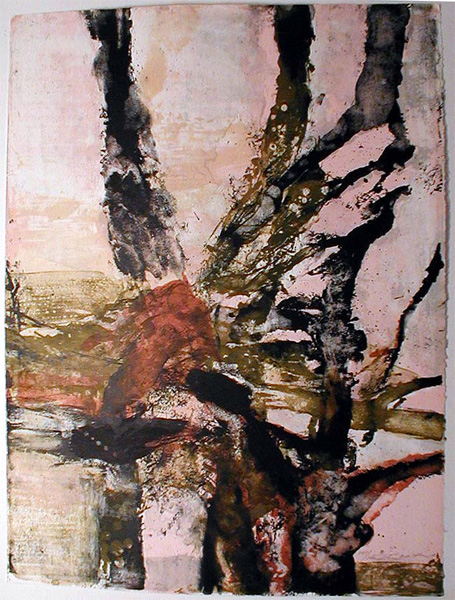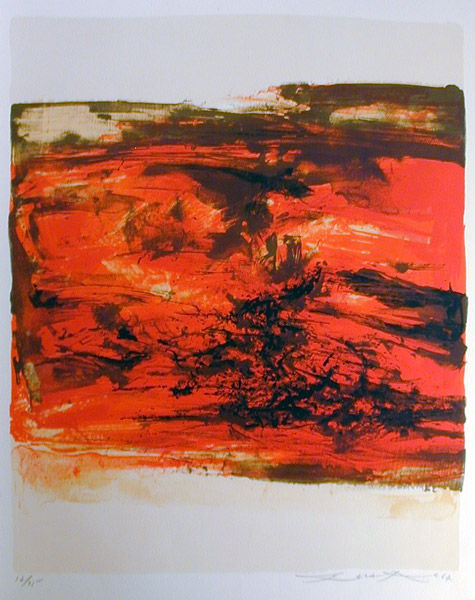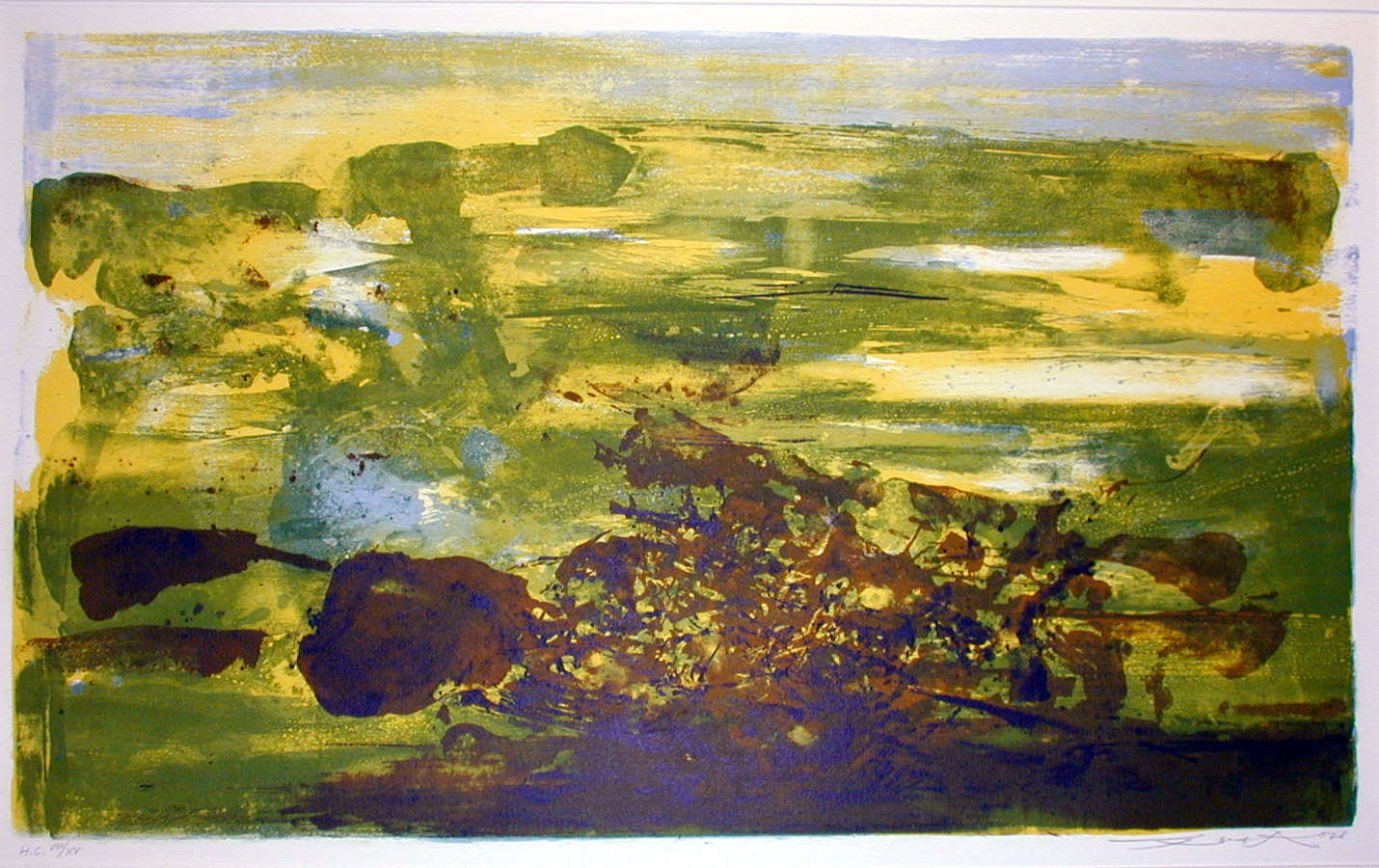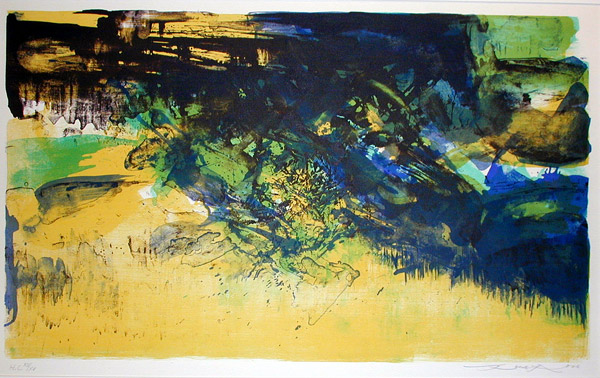|
"Abstraction in art is no more abstract than isolated words in literature" (London: The Studio, 1962)
Zao Wou-Ki is one of trhe most important of the group of lyrical abstractionists active in France from the 1950s on. He was a teen ager in art school in China when the Japanese invasion forced him to leave art school. After the war, he organized several exhibitions of non-traditional Chinese art in China while working on his own painting. He came to Paris in 1948, and spent the afternoon of his first day at the Louvre. He became part of a group (along with Hans Hartung, Nicolas de Staël, Pierre Soulages, Viera da Silva, Sam Francis, Norman Bluhm and Jean-Paul Riopelle) that often met at the Galerie Nina Dausset, rue du Dragon. During the 1960s, during his trapis to the US, he became friends with Barnett Newman, Franz Kline, William Baziotes, Saul Steinberg, and Hans Hoffman. His first exhibition at Galerie Creuze in May 1949 was praised by Mirò, Giacometti, and Picasso. After learning lithography at the Desjobert printing shop, he began producing lithographs; inspired by his lithographs, the writer and artist Henri Michaux wrote a series of eight poems that began a close friendship with the artist. His poetry was published as Lecture de huit lithographies de Zao Wou Ki and the two had a joint exhibition at the galerie La Hune in 1950. Recognition of his work was widespread and his works were widely shown in Europe and the US during the next four decades, including major shows at galleries and museums in Paris, London, Bern, Basel, Lisbon, Luxembourg, Essen, Amsterdam, Geneva, Salzburg, Rome, Milan, Turin, Oslo, Helsinki, Tokyo, Madrid, Cordoba, Montreal, Cambridge MA (at M.I.T. and the Hayden Gallery), Chicago, Cincinnati, Los Angeles, San Francisco, and New York.
Among his most important shows, the following stand out: a retrospective of his engravings at The Cincinnati Museum of Fine Arts (1954); a retrospective in Bern on the occasion of the publication of a catalogue raisonné of his engravings (1955); he exhibited in the French section of the third Biennial of Sao Paulo (1956); in 1960 his works were shown in the Venice Biennial, an exhibition of contemporary French art in Göteborg, the Second International Biennial in Tokyo, and in the Musée des Arts Décoratifs in Paris. Later in the 1960s, his works were shown at the Graphische Sammlung Albertina (Vienna)and at the San Francisco the Museum of Art.
In 1969 he had a second retrospective exhibition at the contemporary art museum in Montreal whoch was then shown at the Musée du Quebec. During the 1970s, 80s, and 90s, his major retrospectives include an exhibition of 80 prints at the Bibliotheque Nationale (Paris), exhibitions at Musée des Beaux-Arts in Tours, at the Vasarely Foundation in Aix, at the Artcurial Gallery in Parisa, his ink paintings on china paper were shown at the Encres de Chine at the Musée National (Luxembourg) and his paintings at the Château de Vianden (Luxembourg), at the Centro Cultural de Arte Contemporaneo in Mexico, at the Kaohsiung Museum of Fine Arts in Taiwan, the Shanghai Museum of Art, the Chinese Palace of Fine Arts (Beijing), the Palace of Fine Arts (Canton), and at the Museum of Fine Arts (Hong Kong), all curated by Daniel Marchesseau. In 2003, Daniel Abadie curated a retrospective at the Museee du Jeu de Paume (Paris).
He also designed the sets for Roland Petit's ballet La Perle and the sets and costumes of Béla Bartòk's The Miraculous Mandarin and The Wooden Prince for the Rhine Opera (Mulhouse, Colmar, Strasbourg).
Honors: Zao is a Commandeur de la Légion d'Honneur, was awarded the Imperial award from Emperor Akihito and Empress Michiko, the Grande Médaille Vermeil de la Ville de Paris, and was elected to the Académie des Beaux Arts, the section of the Académie Française reserved to painters and architects; he has also received an honorary doctorate from the University of Hong Kong.
Select Bibliography: Daniel Abadie and Martine Contensou, Zao Wou-Ki (Barcelona: Ediciiones Poligrafa, 1988); Jorgen Agerup, Zao Wou-Ki. The Graphic Work. A Catalogue Raisonne 1937-1995 (Skorping: Heede & Moestrup, 1994); Arnason, H. H., Martin L. Friedman, et al, School of Paris 1959: The Internationals [Karel Appel, Hans Hartung, Andre Lanskoy, Jean-Paul Riopelle, Gerard Schneider, Pierre Soulages, Maria Helena Vieira da Silva, Zao Wou-Ki (Minneapolis: Walker Art Center, 1959); Pierre Daix, Zao Wou Ki, l'Oeuvre Peint 1935-1993 (Paris: artcurial. 1992); (Nicole d’Huart, Emmanuel Guignon, France Huser, Louis Ucciani, Zao Wou-Ki, Musée d’Ixelles (Valencià: IVAM, Institut d'Art Modern et le Musée d'Ixelles, 2001); Nesto Jacometti, Zao Wou-Ki: Catalogue Raisonne De l'Oeuvre Gravee et Lithographiee 1949-1954 (Berne: Gutekunst & Klipstein, 1955); Jean Leymarie et François Cheng, Zao Wou-Ki: Peintures, Encres de Chine (Paris: Galeries Nationales du Grand Palais, 1981); Françoise Marquet, Zao Wou-Ki, les estampes 1937-1974 (Paris: Yves Rivière - Arts et Métiers Graphiques, 1975); Zao Wou-Ki, Encres, a dialogue between the artist and Françoise Marquet, with a foreword by Henri Michaux; Bernard Noël, Zao Wou-Ki: Encres (Pyrénées-Atlantiques: Séguier, Anglet, nd) ; Robert Rousseau, Grands Tableaux de Zao Wou-Ki (Charleroi: Palais des beaux-arts, 1980; Claude Roy, Zao Wou-Ki (NY: Grove Press, 1960); Claude Roy, Zao Wou-Ki: Le Musee De Poche (Paris, 1970); Dora Vallier, Zao Wou-Ki: En Torno al Gesto (Barcelona, Poligrafa, n.d. [1978]); Zao Wou-ki. La Quête Du silence (Paris, 2004); Zao Wou-Ki. Paintings 1980-1985. Exhibition catalogue (NY: Pierre Matisse Gallery, 1986); Zao Wou-Ki: Exposition (Paris: Jeu de Paum, 2003).
Filmography: Zao Wou Ki, in the series Champs visuels, directed by Pierre Schneider and produced by the ORTF, the national French television.
For an extended biographical sketch of the artist, see http://www.asianart.com/exhibitions/zao/bio.html; for an essay by Jonathan Hay, see http://www.asianart.com/exhibitions/zao/essay.html.
|
|



